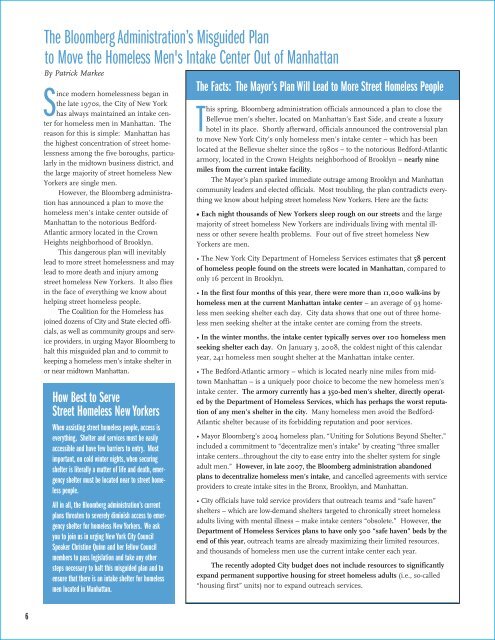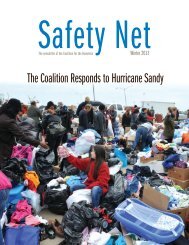The Mayor's Plan Will Lead to More Street Homeless People
The Mayor's Plan Will Lead to More Street Homeless People
The Mayor's Plan Will Lead to More Street Homeless People
You also want an ePaper? Increase the reach of your titles
YUMPU automatically turns print PDFs into web optimized ePapers that Google loves.
6<br />
<strong>The</strong> Bloomberg Administration’s Misguided <strong>Plan</strong><br />
<strong>to</strong> Move the <strong>Homeless</strong> Men's Intake Center Out of Manhattan<br />
By Patrick Markee<br />
Since modern homelessness began in<br />
the late 1970s, the City of New York<br />
has always maintained an intake center<br />
for homeless men in Manhattan. <strong>The</strong><br />
reason for this is simple: Manhattan has<br />
the highest concentration of street homelessness<br />
among the five boroughs, particularly<br />
in the mid<strong>to</strong>wn business district, and<br />
the large majority of street homeless New<br />
Yorkers are single men.<br />
However, the Bloomberg administration<br />
has announced a plan <strong>to</strong> move the<br />
homeless men’s intake center outside of<br />
Manhattan <strong>to</strong> the no<strong>to</strong>rious Bedford-<br />
Atlantic armory located in the Crown<br />
Heights neighborhood of Brooklyn.<br />
This dangerous plan will inevitably<br />
lead <strong>to</strong> more street homelessness and may<br />
lead <strong>to</strong> more death and injury among<br />
street homeless New Yorkers. It also flies<br />
in the face of everything we know about<br />
helping street homeless people.<br />
<strong>The</strong> Coalition for the <strong>Homeless</strong> has<br />
joined dozens of City and State elected officials,<br />
as well as community groups and service<br />
providers, in urging Mayor Bloomberg <strong>to</strong><br />
halt this misguided plan and <strong>to</strong> commit <strong>to</strong><br />
keeping a homeless men’s intake shelter in<br />
or near mid<strong>to</strong>wn Manhattan.<br />
How Best <strong>to</strong> Serve<br />
<strong>Street</strong> <strong>Homeless</strong> New Yorkers<br />
When assisting street homeless people, access is<br />
everything. Shelter and services must be easily<br />
accessible and have few barriers <strong>to</strong> entry. Most<br />
important, on cold winter nights, when securing<br />
shelter is literally a matter of life and death, emergency<br />
shelter must be located near <strong>to</strong> street homeless<br />
people.<br />
All in all, the Bloomberg administration’s current<br />
plans threaten <strong>to</strong> severely diminish access <strong>to</strong> emergency<br />
shelter for homeless New Yorkers. We ask<br />
you <strong>to</strong> join us in urging New York City Council<br />
Speaker Christine Quinn and her fellow Council<br />
members <strong>to</strong> pass legislation and take any other<br />
steps necessary <strong>to</strong> halt this misguided plan and <strong>to</strong><br />
ensure that there is an intake shelter for homeless<br />
men located in Manhattan.<br />
<strong>The</strong> Facts: <strong>The</strong> Mayor’s <strong>Plan</strong> <strong>Will</strong> <strong>Lead</strong> <strong>to</strong> <strong>More</strong> <strong>Street</strong> <strong>Homeless</strong> <strong>People</strong><br />
This spring, Bloomberg administration officials announced a plan <strong>to</strong> close the<br />
Bellevue men’s shelter, located on Manhattan’s East Side, and create a luxury<br />
hotel in its place. Shortly afterward, officials announced the controversial plan<br />
<strong>to</strong> move New York City’s only homeless men’s intake center – which has been<br />
located at the Bellevue shelter since the 1980s – <strong>to</strong> the no<strong>to</strong>rious Bedford-Atlantic<br />
armory, located in the Crown Heights neighborhood of Brooklyn – nearly nine<br />
miles from the current intake facility.<br />
<strong>The</strong> Mayor’s plan sparked immediate outrage among Brooklyn and Manhattan<br />
community leaders and elected officials. Most troubling, the plan contradicts everything<br />
we know about helping street homeless New Yorkers. Here are the facts:<br />
• Each night thousands of New Yorkers sleep rough on our streets and the large<br />
majority of street homeless New Yorkers are individuals living with mental illness<br />
or other severe health problems. Four out of five street homeless New<br />
Yorkers are men.<br />
• <strong>The</strong> New York City Department of <strong>Homeless</strong> Services estimates that 58 percent<br />
of homeless people found on the streets were located in Manhattan, compared <strong>to</strong><br />
only 16 percent in Brooklyn.<br />
• In the first four months of this year, there were more than 11,000 walk-ins by<br />
homeless men at the current Manhattan intake center – an average of 93 homeless<br />
men seeking shelter each day. City data shows that one out of three homeless<br />
men seeking shelter at the intake center are coming from the streets.<br />
• In the winter months, the intake center typically serves over 100 homeless men<br />
seeking shelter each day. On January 3, 2008, the coldest night of this calendar<br />
year, 241 homeless men sought shelter at the Manhattan intake center.<br />
• <strong>The</strong> Bedford-Atlantic armory – which is located nearly nine miles from mid<strong>to</strong>wn<br />
Manhattan – is a uniquely poor choice <strong>to</strong> become the new homeless men’s<br />
intake center. <strong>The</strong> armory currently has a 350-bed men’s shelter, directly operated<br />
by the Department of <strong>Homeless</strong> Services, which has perhaps the worst reputation<br />
of any men’s shelter in the city. Many homeless men avoid the Bedford-<br />
Atlantic shelter because of its forbidding reputation and poor services.<br />
• Mayor Bloomberg’s 2004 homeless plan, “Uniting for Solutions Beyond Shelter,”<br />
included a commitment <strong>to</strong> “decentralize men’s intake” by creating “three smaller<br />
intake centers…throughout the city <strong>to</strong> ease entry in<strong>to</strong> the shelter system for single<br />
adult men.” However, in late 2007, the Bloomberg administration abandoned<br />
plans <strong>to</strong> decentralize homeless men’s intake, and cancelled agreements with service<br />
providers <strong>to</strong> create intake sites in the Bronx, Brooklyn, and Manhattan.<br />
• City officials have <strong>to</strong>ld service providers that outreach teams and “safe haven”<br />
shelters – which are low-demand shelters targeted <strong>to</strong> chronically street homeless<br />
adults living with mental illness – make intake centers “obsolete.” However, the<br />
Department of <strong>Homeless</strong> Services plans <strong>to</strong> have only 500 “safe haven” beds by the<br />
end of this year, outreach teams are already maximizing their limited resources,<br />
and thousands of homeless men use the current intake center each year.<br />
<strong>The</strong> recently adopted City budget does not include resources <strong>to</strong> significantly<br />
expand permanent supportive housing for street homeless adults (i.e., so-called<br />
“housing first” units) nor <strong>to</strong> expand outreach services.












